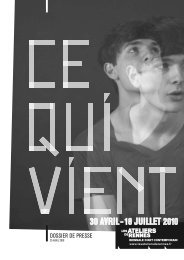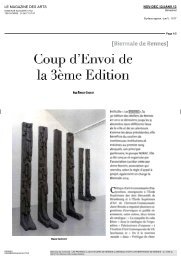Download here the Visitor's guide. - Les Ateliers de Rennes
Download here the Visitor's guide. - Les Ateliers de Rennes
Download here the Visitor's guide. - Les Ateliers de Rennes
You also want an ePaper? Increase the reach of your titles
YUMPU automatically turns print PDFs into web optimized ePapers that Google loves.
52<br />
<strong>Les</strong> Prairies's artists<br />
JAN KEMPENAERS<br />
Spomenik #1 (Podgaric), 2007. Collection Mu.ZEE, Osten<strong>de</strong>.<br />
© Adagp, Paris 2012.<br />
KILUANJI KIA HENDA<br />
Kiluanji Kia Henda seeks to convey, at a remove, <strong>the</strong> history of his<br />
country, <strong>de</strong>stroyed by civil war and colonisation, and to construct<br />
fictions that explore as much <strong>the</strong> past as <strong>the</strong> future. Lunda In The<br />
Sky with Diamonds I represents an Angolan landscape <strong>de</strong>stroyed<br />
by diamond mining, an economy which <strong>the</strong> Angolans <strong>the</strong>mselves<br />
miss out on even though it is <strong>the</strong>y who extract <strong>the</strong> stones from<br />
<strong>the</strong> mine. Balumuka (Ambush) shows an open-air transit zone<br />
in Luanda, <strong>the</strong> Angolan capital. It is a graveyard for old objects,<br />
machines, and fragments of old monuments. The fortuitous<br />
juxtapositions re-enact historical scenes: colonial heroes rub<br />
shoul<strong>de</strong>rs with Angolan sovereigns and military weapons. These<br />
epic, ra<strong>the</strong>r grotesque scenes are evi<strong>de</strong>nce of <strong>the</strong> difficulty <strong>the</strong><br />
country has in preserving its heritage. Re<strong>de</strong>fining The Power<br />
III (with Miguel Prince) is a <strong>the</strong>atrical style staging of our<br />
relationship with history and mocks <strong>the</strong> importance attached to<br />
monuments and statuary in Angolan public space. Taking empty<br />
colonial-era pe<strong>de</strong>stals from which <strong>the</strong> statues were removed at<br />
<strong>the</strong> time of Angolan In<strong>de</strong>pen<strong>de</strong>nce, <strong>the</strong> artist invited performers<br />
to occupy <strong>the</strong> place vacated by <strong>the</strong> coloniser. These improvised<br />
heroes, formerly colonised people, adopted comically satirical<br />
attitu<strong>de</strong>s of power. Although Kiluanji Kia Henda has realized an<br />
ephemeral dream, it is above all a call for <strong>the</strong> possibility of a new<br />
way of remembering.<br />
C. P. tr. J. H.<br />
Born in 1979 in Luanda (Angola), w<strong>here</strong> he lives and works.<br />
Jan Kempenaers is best known for his large-scale<br />
panoramas of industrial and urban landscapes in<br />
Europe, <strong>the</strong> United States and Japan. In his fascination<br />
for <strong>the</strong> hybrid nature of today's landscapes, Kempenaers<br />
interrogates <strong>the</strong> 18th century notion of <strong>the</strong> 'picturesque'.<br />
His series Spomenik (2007) is an attempt to capture<br />
what remains of <strong>the</strong> monuments (spomenik) that were<br />
erected un<strong>de</strong>r Tito in <strong>the</strong> 1960s and 70s to commemorate<br />
communist resistance to Nazi occupation. These<br />
monumental sculptures with <strong>the</strong>ir powerfully expressive<br />
geometric forms are to be found in strategic and<br />
symbolic locations. They are constructed in long-lasting<br />
architectural materials like concrete, steel and granite.<br />
After <strong>the</strong> confusion of <strong>the</strong> ethnic wars that followed <strong>the</strong><br />
break-up of Yugoslavia many of <strong>the</strong>se formally diverse,<br />
Brutalist monuments were <strong>de</strong>stroyed, while o<strong>the</strong>rs<br />
were simply abandoned. These strange memorials are<br />
baffling to recent generations. Stripped of <strong>the</strong> trappings<br />
of social and political i<strong>de</strong>ology as well as of <strong>the</strong>ir<br />
commemorative function, <strong>the</strong>y raise <strong>the</strong> question as to<br />
how far, after "<strong>the</strong> end of history", an 'object' can acce<strong>de</strong><br />
to <strong>the</strong> status of pure sculpture in its own right.<br />
N. L. tr. J.H<br />
Born in 1968 in Anvers (Belgium), lives and works in<br />
Gand (Belgium).<br />
Balumuka – Ambush, 2010. Courtesy of <strong>the</strong> artist and Galeria<br />
Fonti, Naples.






